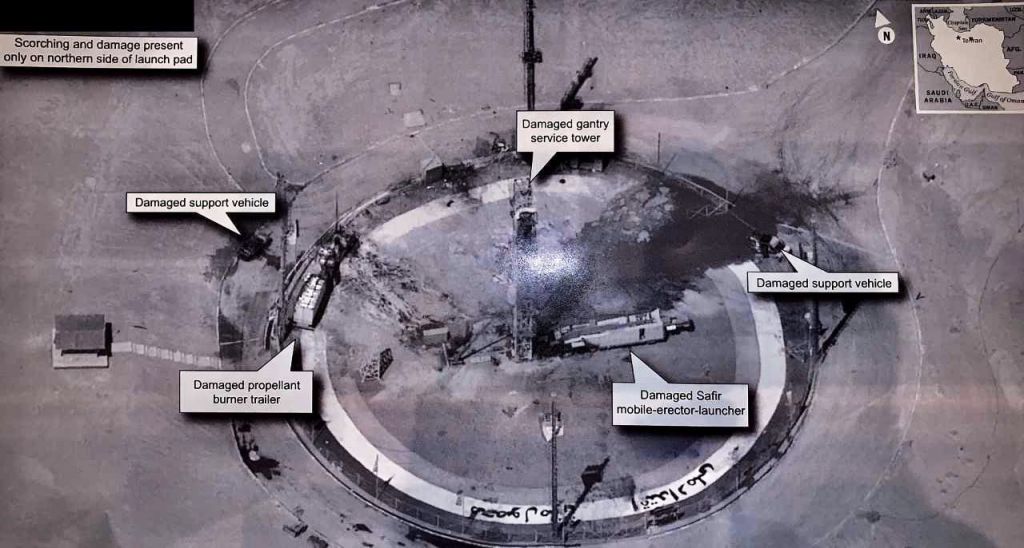Sleuths Find the Top-Secret (and Classified) Satellite Behind Trump's Tweeted Photo

It was only a matter of time: Amateur sleuths think they've tracked down the satellite that took a high-resolution image of the aftermath of an Iranian missile disaster.
President Donald Trump tweeted out the photograph on Aug. 30, writing, "The United States of America was not involved in the catastrophic accident during final launch preparations for the Safir SLV launch at Semnan Launch Site One in Iran. I wish Iran best wishes and good luck in determining what happened at Site One." Intelligence experts immediately noticed the high resolution of the photograph and pegged it as likely classified — classified, that is, until the president declassified it with his tweet. Many experts told news agencies that they were concerned that the declassified photo could reveal unknown information about U.S. drone or satellite surveillance.
Related: Flying Saucers to Mind Control: 22 Declassified Military & CIA Secrets
Apparently, they were right. Amateur satellite trackers have reverse-engineered the image and figured out that it likely came from the highly classified USA 224 satellite. USA 224 is suspected to be a KH-11 surveillance satellite, a classified piece of equipment about which the public knows little.
"It's basically a very large telescope, not unlike the Hubble Space Telescope," satellite tracker Marco Langbroek of the Netherlands told MPR News. "But instead of looking up to the stars, it looks down to the Earth's surface and makes very detailed images.
Even classified satellites are easy to spot, said Purdue University graduate student Michael Thompson, who tracks satellites in his spare time. Thompson told MPR News that once a satellite is spotted, calculating where it will be in its orbit at any given time just takes some simple math.
According to the online network of trackers, shadows in the pictures Trump tweeted enabled sleuths to determine what time the photograph was taken. Langbroek was also able to calculate the viewing angle by looking at the obliqueness of the circular launchpad. From there, he and his co-trackers matched the photograph to the closest satellite at the time, which was USA 224.
Get the Space.com Newsletter
Breaking space news, the latest updates on rocket launches, skywatching events and more!
Related: 15 Secretive Places You Can Now See on Google Earth (and 3 You Can't)
The United States of America was not involved in the catastrophic accident during final launch preparations for the Safir SLV Launch at Semnan Launch Site One in Iran. I wish Iran best wishes and good luck in determining what happened at Site One. pic.twitter.com/z0iDj2L0Y3August 30, 2019
That revelation is surprising, as many experts had believed that the crystal-clear imagery in the launchpad photo must have come from a drone. It's a challenge to get such a clear view through Earth's atmosphere, Melissa Hanham, a satellite imagery expert and deputy director of the Open Nuclear Network in Vienna, told MPR News.
"I imagine adversaries are going to take a look at this image and reverse-engineer it to figure out how the sensor itself works and what kind of postproduction techniques they're using," Hanham said.
In a blog post, Langbroek detailed the analysis that led to the identification of the satellite. He also puzzled over the president's choice to tweet out the imagery. "The KH-11 satellites are classified, and so is imagery from these satellites. If an adversary gets her hands on KH-11 imagery, it reveals information about the optical capacities of these space assets," Langbroek wrote. "In 1984, a Navy intelligence analyst was sent to prison for leaking three KH-11 images to the press."
- The 22 Weirdest Military Weapons
- Photos: Top-Secret, Cold War-Era Military Base in Greenland
- The 10 Most Outrageous Military Experiments
Originally published on Live Science.
Join our Space Forums to keep talking space on the latest missions, night sky and more! And if you have a news tip, correction or comment, let us know at: community@space.com.

Stephanie Pappas is a contributing writer for Space.com sister site Live Science, covering topics ranging from geoscience to archaeology to the human brain and behavior. She was previously a senior writer for Live Science but is now a freelancer based in Denver, Colorado, and regularly contributes to Scientific American and The Monitor, the monthly magazine of the American Psychological Association. Stephanie received a bachelor's degree in psychology from the University of South Carolina and a graduate certificate in science communication from the University of California, Santa Cruz.










